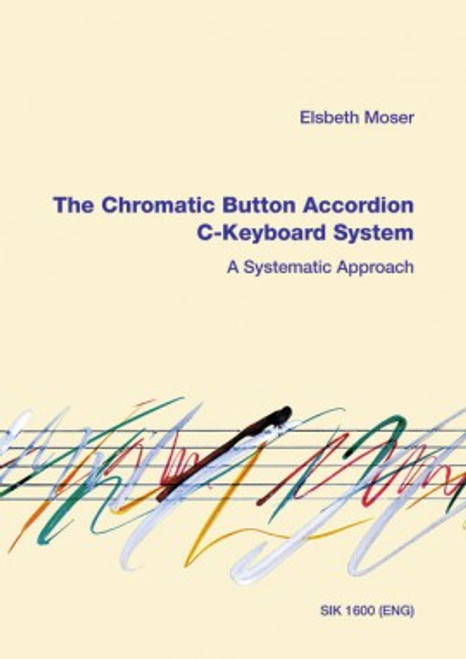METHODE C KEYBOARD SYSTEM POUR ACCORDEON
AUTEUR: ELSBETH MOSER
NIVEAU: 1er Cycle
COMMENTAIRE: Forte de ses nombreuses années d'expérience en tant qu'accordéoniste et professeur, Elsbeth Moser a réalisé un ouvrage de base pour apprendre à jouer de l'accordéon à boutons. L’école d’accordéon de Moser se rapporte à l’accordéon à boutons du clavier C et transmet les connaissances de base essentielles de l’instrument menant aux plus grands défis liés au jeu de l’accordéon à boutons.
SOMMAIRE: Introduction – an Approach to Learning the Chromatic Button Accordion
Chapter 1 – The Direction Problem
The Verticals
Exercise 1
Exercise 2
Chapter 2 – The Intervals on the Vertical
2.1 The Minor Third
2.2 The Tritone
2.3 The Major Sixth
2.4 The Octave
Chapter 3 – The Vertical Range Exercises
3.1 Range Exercises with Individual Tones
3.2 Range Exercises with Minor Thirds
3.3 Range Exercises with Tritones
3.4 Range Exercises with Major Sixths
3.5 Range Exercises with Perfect Octaves
3.6 Exercises
Explanation of the Symbols
Chapter 4 – The Chromatics
4.1 The Diagonal and the Direct Path
4.2 The Horizontal and the Indirect Path
4.3 The Bridge
4.4 Range Exercises
4.4.1 Chromatically ascending and descending
4.4.2 Minor Thirds chromatically ascending
4.4.3 Tritones chromatically ascending
4.4.4 Major Sixths chromatically ascending
4.4.5 Perfect Octaves chromatically ascending
4.5 The Linear Chromatic Scale
4.5.1 Exercises, Chromatic In Parallel Motion
4.5.2 Exercises, Chromatic In Contrary Motion
4.6 Simultaneous and Successive Exercises in Identified Intervals
4.6.1 Exercises in Minor Thirds
4.6.2 Exercises in Tritones
4.6.3 Exercises in Major Sixths
4.6.4 Exercises in Perfect Octaves
Chapter 5 – Four Other Intervals that Proceed Outward from C
On the Direct Path from the First Row to the Second Row
Major Third
Perfect Fifth
Minor Seventh
Minor Ninth
Formula 1 (Motto: to find something new, build upon something familiar)
Exercises
1. Vertical Range Exercises, Ascending and Descending
2. Chromatic Range Exercises
3. Interval Exercises – simultaneous chromatics
4. Interval Exercises – successive chromatics
Lessons 1 – 4
Playing the chains
Summary
Chapter 6 – The Five Remaining Intervals
Major Second
Perfect Fourth
Minor Sixth
Major Seventh
Major Ninth
The Direct Path and the Auxiliary Row
Formula 2
The relationships in the arrangement of the keys
The transformation from the indirect to the direct path
Chapter 7 – The Study of All of the Intervals on the Indirect Path
The Interception Process
Exercises 1 and 2: Connecting the Indirect and Direct Paths
Formula 3
Exercise 3: To Prepare for Fingering Variations A and B
Formula 4
Application of Fingering Variations A and B Using Examples
Chapter 8 – Chromatic Variations for the Preceding on Intervals
Building the Thirds
Building the Fourths
Chapter 9 – The Chords and Their Structure
9.1 Triads
Exercises for Triads
9.2 Tetrachords
Exercises for Tetrachords
9.3 Pentachords
Examples of Pentachords
Chapter 10 – The Major Scales and their Three Basic Fingerings
10.1 The Ascending Constellations
Example: Sonata in D Minor by Domenico Scarlatti
10.2 The Descending Constellations.
10.3 Overview of the Basic Fingerings
10.3.1a First basic fingering, ascending
10.3.1b First basic fingering, descending
10.3.2a Third basic fingering, ascending
10.3.2b Third basic fingering, descending
10.3.3a Second basic fingering, ascending
10.3.3b Second basic fingering, descending
10.4 Basic exercises
Chapter 11 – The Primary Five–Note Exercises In Major Keys
Chapter 12 – The Primary Five–Note Exercises In Minor Keys
Chapter 13 – Conclusion: Recognize – Think – Do
“After–Thoughts” by Klaus–Ernst Behne
Référence

